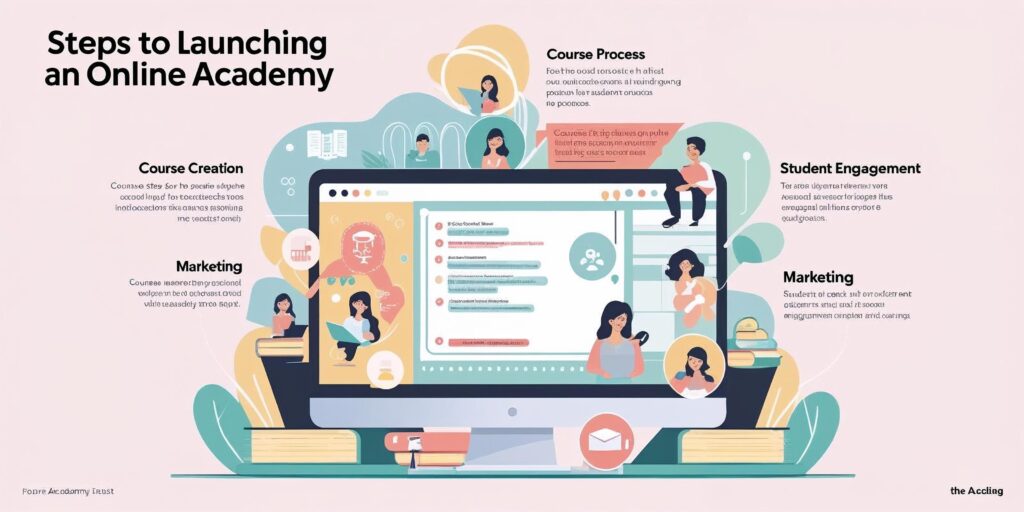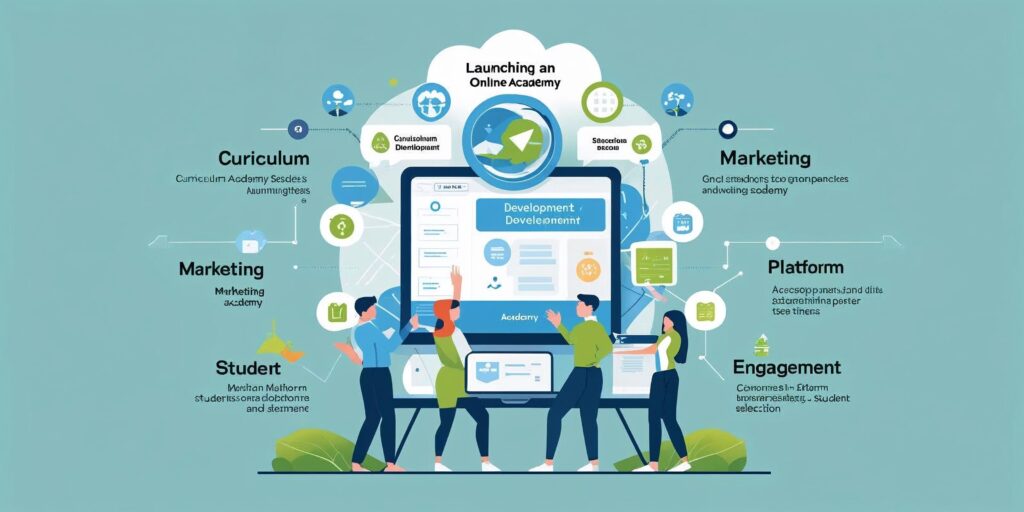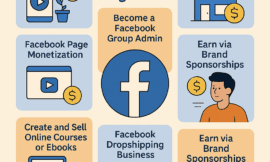How to Launch Your Online Academy (Beginner’s Guide with Real Examples)
Starting your own online academy is one of the most rewarding and scalable ways to share your knowledge, build a personal brand, and earn income in 2025. Whether you’re a teacher, coach, subject expert, or just passionate about a skill, you don’t need a physical classroom anymore.
In this post, I’ll walk you through everything you need to launch your online academy—step-by-step—like I’m sitting right next to you. We’ll cover everything from choosing your niche to marketing and monetizing. And yes, I’ll include real examples and mistakes you should avoid.
🧠 Why Start an Online Academy?
Before we dive in, let’s understand the why.
💡 Global E-Learning Market is Booming
As per a recent report by Statista, the global eLearning market is projected to reach $474 billion by 2026, growing rapidly post-pandemic. Platforms like Udemy, Coursera, and Teachable have empowered millions to teach online.
But here’s the best part—you don’t need to be famous or have a degree to start. All you need is valuable knowledge and a system to share it.

🔍 Step 1: Choose a Profitable Niche
Don’t try to teach everything. Focus.
Your niche should sit at the intersection of:
- Something you’re good at
- Something people want to learn
- Something people are willing to pay for
✅ Examples of Profitable Niches
- Digital Marketing (Facebook Ads, SEO)
- Coding for Beginners (Python, Web Dev)
- Graphic Design with Canva
- Spoken English or IELTS Coaching
- Yoga for Back Pain Relief
- Finance for Young Professionals
- Productivity for Creators
Real example: Rachana Ranade, an Indian finance educator, built a ₹10+ crore business by teaching personal finance in Hindi via online video courses.
🚀 Explore Our Top Guides
Hand-picked articles to help you grow, earn, and learn in 2025
📚 Best Online Platforms to Sell Courses in 2025
Compare 25 top platforms to launch and grow your online course business.
🎥 25 Studio Ghibli Films That Will Change the Way You See Animation
A magical collection that inspires creativity, storytelling, and wonder.
💰 Top 25 Ways to Earn Money with AI
Discover realistic and profitable AI income strategies for 2025.
🎬 Best AI Tools for YouTubers in 2025
Level up your content creation with smart, time-saving tools.
🤖 How to Use ChatGPT for Business
Automate, write, and grow with practical use cases of ChatGPT in business.
✍️ Step 2: Validate Your Idea (Don’t Skip This)
Before you spend months recording videos, make sure people are actually interested.
🛠️ Validation Techniques
- Ask your audience on Instagram or LinkedIn
- Run a small poll or quiz
- Offer a free webinar or workshop
- Create a waitlist page using Systeme.io or ConvertKit
- Post a YouTube video and see engagement
If at least 100 people show interest in a free webinar or waitlist, you’re ready.
Tip: Don’t ask, “Would you buy this course?” — ask “What’s your biggest struggle with [topic]?”
📚 Step 3: Outline Your Course or Curriculum
You don’t need to start with 20 modules.
Start with just 1 signature course or learning path.
🧩 Plan Structure Like This:
- Module 1: Introduction to the topic
- Module 2: Key foundation
- Module 3: Real-world applications
- Module 4: Advanced techniques
- Module 5: Bonus Content/Templates
- Final: Quiz or certificate
Example:
For “Instagram Growth for Beginners”:
- Module 1: Setting up your profile
- Module 2: Content pillars
- Module 3: Hashtags & SEO
- Module 4: Monetizing your audience
- Module 5: Tools + AI tips
🎥 Step 4: Choose How to Deliver Lessons
There are 3 main formats:
1. Pre-recorded Video Lessons
✅ Best for: Scalability
🎥 Use Loom, OBS Studio, or your smartphone
💡 Tip: Keep lessons short (5–10 minutes)
2. Live Classes (Zoom, Google Meet)
✅ Best for: Coaching, feedback
💡 Add recordings later for rewatching
3. Text-Based + PDFs + Assignments
✅ For PDF lovers or B2B audiences
📝 Tools: Notion, Google Docs, Systeme.io’s course builder
Pro Tip: Don’t overthink production. Value > Fancy camera.
🏗️ Step 5: Choose a Platform to Host Your Academy
Now let’s talk about your academy’s “home.”
🔍 Platform Options (Simple Breakdown):
📊 Platform Comparison Table
Compare popular platforms to launch your online academy
| Platform | Best For | Free Plan? | Notable Features |
|---|---|---|---|
| Teachable | Coaches, educators | ✅ | Easy interface, quizzes |
| Thinkific | Professional courses | ✅ | Free forever plan |
| Systeme.io | All-in-one marketing | ✅ | Funnels, email, course |
| Kajabi | Premium creators | ❌ | High-ticket sales |
| Gumroad | Digital downloads + courses | ✅ | No upfront fee |
| Graphy (India) | Creators in India | ✅ | Courses + community |
| LearnWorlds | Full academy setup | ✅ | Advanced analytics |
If you’re starting from scratch, Systeme.io or Teachable is perfect.
🖼️ Step 6: Design a Simple But Strong Website
Your online academy needs:
- ✅ A homepage explaining your value
- ✅ About you (your credibility/story)
- ✅ Course page with pricing
- ✅ FAQs, contact form, testimonials
Use drag-and-drop page builders like
- WordPress + Elementor
- Systeme.io (in-built)
- Carrd (for one-page sites)
- Wix/Squarespace
Example: Sarah’s Fitness Academy uses one landing page to sell a ₹3,000 workout course with a free trial.
📧 Step 7: Build an Email List from Day 1
“Money is in the list.”
Don’t wait to collect emails. Start with a free lead magnet like
- Checklist (e.g., “5 Mistakes New Programmers Make”)
- Mini ebook or guide
- Free 15-minute class
Tools to use:
- ConvertKit (free up to 1,000 subs)
- Systeme.io (2,000 free contacts)
- MailerLite
- Beehiiv (for newsletters)
Send weekly emails with tips, videos, offers, or progress updates.
20 Advanced WordPress Page Optimization Tips to Skyrocket Your Website Performance
32 Best Self-Help Books for Personal Growth
Brand24: The Ultimate Social Media Monitoring Tool for 2025
📣 Step 8: Launch Your First Course
You don’t need a huge audience to launch.
🪄 Use This 3-Step Launch Method:
- Warm-up Phase (1 week):
Tease your course. Share stories, tips, and behind-the-scenes. - Launch Week (5–7 days):
- Send emails daily
- Offer early-bird discount
- Do a live Q&A on Instagram or YouTube
- Close Cart or Continue Evergreen:
- Scarcity = better sales
- Then make it self-paced for new buyers
Bonus Tip: Use “urgency”—“Only 30 spots at ₹999” or “Offer ends in 48 hours.”
💰 Step 9: Price It Right (Don’t Sell Too Cheap)
Here’s a smart pricing strategy:
💸 Course Pricing Formats
Choose the right pricing model for your course type
| Course Type | Ideal Price (INR) | Format |
|---|---|---|
| Mini Course | ₹499–₹999 | Short videos + PDF |
| Flagship Course | ₹2,000–₹5,000 | Full transformation |
| Coaching | ₹10,000–₹1L | Live + group sessions |
| Membership | ₹299–₹999/mo | Ongoing access |
Always start with beta pricing. Get testimonials, improve the course, and then increase the price.
📱 Step 10: Promote Like a Creator
You need traffic. No one buys what they don’t know exists.
🔥 Organic Strategies
- Share value on YouTube (e.g., “Top 3 Tools I Use as a Freelance Designer”)
- Post carousels on Instagram or LinkedIn
- Create reels or Shorts with transformation stories
- Collaborate with micro-influencers
💸 Paid Ads (Once You’re Ready)
- Facebook + Instagram Ads (₹200/day to start)
- Google Search Ads for niche topics
Use Systeme.io or ThriveCart to manage checkout, coupons, and sales tracking.
🧪 Step 11: Keep Improving Based on Feedback
Ask students:
- “What part did you find confusing?”
- “What do you wish was included?”
- “Would you recommend this course?”
Improve content every 30–60 days. Add worksheets, case studies, guest videos, or quizzes.
Also, automate feedback with Google Forms or Typeform.

🧠 Bonus: Turn Your Academy into a Brand
Once your first course is live:
- Add more courses = multiple revenue streams
- Start a podcast to attract a new audience
- Publish a book based on your course
- Host webinars or bootcamps every month
- Build a community on WhatsApp, Discord, or Facebook Groups
Example: Coach Ajit from India started a ₹999 course on productivity and built a brand that now offers 10+ courses and earns 6 figures monthly.
✅ Tools to Help You Launch Faster
🧰 Essential Tools for Launching Your Online Academy
Use these tools to make course creation, marketing, and management easier
| Tool | Purpose |
|---|---|
| Canva | Thumbnails, promo banners |
| Loom | Screen recording for tutorials |
| ChatGPT | Scripting, lesson planning |
| Google Docs | Scripts, planning |
| Pictory | Convert blog to video |
| Notion | Course structure, collaboration |
| Zapier | Automations |
| Trello | Project management |
| Stripe or Razorpay | Payments |
| Google Analytics | Traffic insights |
✨ Final Thoughts on How to Launch Your Online Academy
Launching an online academy isn’t rocket science—it’s about helping others and packaging your expertise in a way that delivers value.
You don’t need a fancy studio.
You don’t need 1,000 subscribers.
You just need to start.
Whether you’re teaching coding, cooking, or career tips—there’s someone out there who’s willing to learn from you.
So don’t wait for perfect. Record your first lesson. Share your knowledge. Change lives—starting with your own.
📌 Ready to Launch?
- ✅ Choose your niche
- ✅ Record 3–5 lessons
- ✅ Pick a platform (Teachable, Systeme.io, etc.)
- ✅ Set up your email list
- ✅ Launch with confidence!
Let me know in the comments—what’s stopping you from launching your own academy?
Related: How To Create An Online School In 5 Easy Steps
Frequently Asked Questions
How do I launch my online course?
To launch your online course, choose a platform, create valuable content for a specific audience, set your pricing, and promote it through email, social media, and your network.
How do you start your own academy?
To start your own academy, select a niche, build structured courses, choose a hosting platform, set up payments, and market it to your target audience online.
How do you start your online classes?
To start your online classes, choose a subject, create lesson plans, use tools like Zoom or Google Meet, and invite students through email or social media.
How to sell an online course?
To sell an online course, host it on a platform like Teachable or Graphy, set a clear price, and market it using email campaigns, social media, and affiliate promotions.












